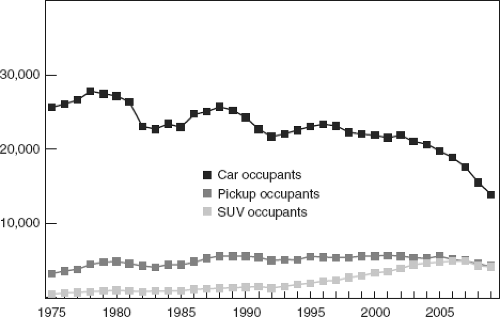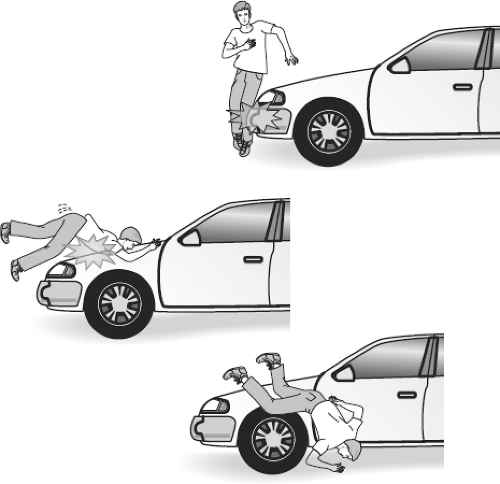Introduction to Trauma: Mechanism of Injury
Gregory J. Jurkovich
L. D. Britt
Mechanism of Injury
Trauma, or physical force injury, occurs from blunt, penetrating, or thermal mechanisms. The distinction of the cause of the injury is more than just nomenclature: The mechanism of injury often dictates specific management approaches. These mechanisms of physical force injury are divided into more specific categories (Table 22-1). While each trauma registry has their own shorthand nomenclature for injury mechanism, this table outlines the most commonly used shorthand descriptors.
Blunt Trauma
I. Motor Vehicle Crashes (MVCs) (Fig. 22-1)
Injuries are produced by the rapid decrease in velocity over a short distance (deceleration). Severity of injury depends on energy transferred during deceleration as a result of a crash.
MVCs account for 30% to 40% deaths from unintentional causes.
MVCs cause at least half of closed head and spinal cord injuries.
The risk of a major injury increases 3- to 5-fold if the patient is ejected (including a 1 in 13 risk of spinal column injury).
Highest risk of injury in MVCs occurs if there is a death of another occupant, partial or complete ejection of the patient, or >12 in. of intrusion on the occupant side and >18 in. of intrusion anywhere, including the roof.
MVCs involve three types of collisions:
Primary collision—motor vehicle impacts another object
Secondary collision—patient strikes internal components of the car
Deceleration-induced deformation—results in differential movement of fixed and nonfixed anatomic parts (e.g., shearing injury to the brain or transection of the thoracic aorta)
Determinants of injury
Magnitude of force (force = mass × acceleration)
Location of patient (front seat vs. back seat; driver vs. passenger)
Restraint devices (Table 22-2)
Injury risk is greatest in the unrestrained patients.
Lap belts alone decrease mortality by 50% (but with an increased rate of abdominal injury).
The lap belt is designed to fit across the pelvis (the anterior superior iliac spines). If inappropriately worn high over the abdomen, anterior compression fractures of the upper lumbar spine (chance fractures) can occur. Lap belt contusions (“seat-belt sign”) are associated with pancreatic, bowel, mesentery, and aortic injury. Lap belt contusion and chance fracture in children are associated with a 65% incidence of bowel injury.
Table 22-1 Major Mechanisms of Injury and Their Subheadings as Identified in Most Trauma Registries
Blunt trauma
Penetrating trauma
Thermal trauma
Other/MSC
Motor vehicle crash (MVC)
Gunshot (GSW) or firearm
Burn (BU), flame
Hanging, strangulation or suffocation (ST)
Motorcycle crash (MCC)
Shotgun (SGW)
Burn, chemical
Drowning (DR)
Pedestrian versus automobile (PV)
Stab (SW) or knife (KN) or cut, pierce
Burn, inhalation injury
Electrocution (ES)
Fall (FL)
Poisoning
Assault (AS)
Blunt instrument (B)
Bicycle (BI) or pedal cycle
Nonaccidental trauma (NAT) or child abuse (CH)
Machinery or equipment (ME)
Sports or play (SP)
Three-point constraints plus airbags provide the optimal protection, especially in front-end collisions.
Secondary collisions of occupant with the vehicle are reduced with the utilization of three-point restraints. Ejection is prevented and mortality is substantially decreased.
Three-point constraints are not designed to prevent extremity injuries. Also, there is no effect on major injury patterns with side impact collisions.
Shoulder belt should not be worn without the lap component; the driver and passengers can slip under this restraint.
Shoulder belt injuries are associated with multiple vascular injuries, including intimal damage or thrombosis of innominate, subclavian, carotid, or vertebral arteries.
Airbags allow a less traumatic deceleration when compared to three-point restraints. The proportion and severity of lower extremity injuries are increased relative to torso and head injuries. However, airbags can cause injuries to occupants who are facing backward or leaning against the steering wheel or into another passenger’s compartment.
Table 22-2 Restraint Devices
A. Lap belt
B. Shoulder belt
C. Shoulder and lap belts
D. Airbags (frontal and side impact)
Unrestrained
The majority of injuries in frontal crashes are a result of impact with the steering wheel, windshield, dashboard, or floorboards. These injuries include the head and neck (10% to 37%), thorax (46%), abdomen (5% to 10%), upper extremities (46%), and lower extremities (33% to 66%).
Frontal impacts account for slightly greater than 50% of motor vehicle occupant fatalities, side impacts for 27%, and rollover impact for about 20%.
Lateral crashes (“T-bone”)
A lateral crash can result in direct impact between the vehicle and the occupant because of the limited space between the driver and the colliding vehicle.
Because there is little substantive material to blunt such an impact, lateral impact collisions are associated with twice the mortality of frontal impacts.
Greater than 12 in. of intrusion on the occupant side signify a greater than 20% chance of significant injury.
The occupant is projected into the next compartment.
Rear-end impact collisions
Rear-end impact collisions do not usually cause severe injuries, with only 8% of crashes resulting in serious injury.
An extension–flexion injury (“whiplash”) is common.
Rollover collisions
Because of the random nature of these collisions, force vectors vary.
Kinetic energy of the car is usually dissipated over a long distance.
Roof collapse can produce severe head injury, and >18 in. of roof or any sidewall intrusion is associated with 20% likelihood of severe injury.
Axial load forces can result in compression fractures of the spine.
Ejection
Partial or complete ejection of an occupant is highly associated with severe injury. Along with death of an occupant, this is the leading indicator of likelihood of severe injury.
II. Motorcycle Crashes
Unlike MVCs, the driver or passenger usually absorbs all the impact and the associated kinetic energy.
The majority (75%) of motorcycle deaths are from head injury.
Spine, pelvis, and extremity injuries are also common, with pelvic fractures particularly severe and life-threatening.
There is a high risk of limb loss with open or severe injury to the tibia and fibula.
IV. Pedestrian–Automobile
Although pedestrian–automobile impacts account for only 2% of traffic injuries, they account for 13% of traffic-related deaths. Children, the elderly, and the intoxicated are more at risk for this mechanism of injury. The pattern of injury is depicted in Figure 22-2. Torso trauma (chest, abdomen, and pelvis) represents 6% of the injuries; however, musculoskeletal and intra-abdominal are more common (35% and 27%, respectively).
This type of impact often results in Waddle’s triad of injury: (1) Tibiofibular or femur fracture, (2) truncal injury, and (3) craniofacial injury. Therefore, a patient with two components of Waddle’s triad of injury should be assumed to have the third component as well.
In general, small children tend to be “run over” and adults “run under” or thrown over the car with impact onto the street.
A lateral compression pelvic fracture can occur as a result of contact between the hip and the fender of the motor vehicle.
IV. Falls
Falls in the elderly, including ground level falls, are the leading cause of unintentional injury fatality in the United States, having recently surpassed MVC for this distinction. Anticoagulation medications and other comorbidities contribute.
Injuries sustained in falls depend on distance of fall, surface struck, and the position on impact.
Energy at impact is the product of the patient’s weight times distance of fall times gravitational forces.
Kinetic energy is dissipated on impact throughout the skeleton and soft tissues.
Duration of impact (i.e., how quickly the patient stops) is critical in determining injury severity.
Impact force over a shorter time increases the magnitude of injury.
Harder surfaces increase severity of injury because of immediate deceleration and transfer of all energy to the body (e.g., concrete vs. grass, sand, or snow).
Falls of 2 to 3 times the height of the patient are associated with more injury: >20 ft in adults and >10 ft in children. Three story falls have a mortality of 50%. Survival is rare in free falls from above five stories.
Injury patterns differ depending on how the patient lands. If the patient lands on his or her feet from a height above 10 to 15 ft, the injuries may include calcaneal, lower extremity, pelvis, and spine fractures. Thoracic aorta and renal injuries can also occur.
Falls with a horizontal orientation result in greater energy dissipation and fewer injuries. This is a less predictable injury pattern and includes craniofacial trauma, hand and wrist fractures, along with abdominal and thoracic visceral injuries.
V. Assaults (fisticuffs, kicking, stomping, striking with an object)
Young males are the most commonly injured by this mechanism, with injury patterns being variable (depending on the weapon, position of the person being assaulted, and the magnitude and intensity of the attack).
Head and facial injuries are more common (72%).
Defensive posturing of the patient usually results in lower extremity injuries (10%).
Severe torso injuries (including pancreatic and hollow viscus injuries) can occur from a stomping or kicking injury.
An intoxicated assault patient with a depressed level of consciousness has an intracranial injury until proven otherwise.
Penetrating Trauma
I. Gunshot wounds (GSWs)
Introduction
To understand the mechanisms of gunshot injuries, it is important to understand the nature of firearms and their projectiles. Ballistics is defined as the scientific study of projectile motion and is divided into three categories: Internal, external, and terminal ballistics. Internal ballistics has to do with the projectile within the firearm. External ballistics describes the projectile in the air. Terminal ballistics relates to actions of the projectile in its target. Wound ballistics is a subset of terminal ballistics; it is the most important aspect of ballistics for physicians to understand. However, to completely understand the wounding process some knowledge of all aspects of ballistics is necessary.
Stay updated, free articles. Join our Telegram channel

Full access? Get Clinical Tree








